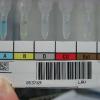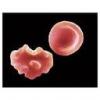Reputation Activity
-
 David Saikin got a reaction from Dansket in Some insight please
David Saikin got a reaction from Dansket in Some insight please
I like to run an ABO compatible cord cell or 2 when I do a cold screen. I will run 3 screening cells, an auto, and 2 cord cells at immed spin, after 5 minutes at room temp and then again after 5 min at 4C. I may also run an A1 and A2 cell if the pt is an A or AB and I suspect anti-IH - just for fun. You have to read the 4C tubes very quickly after centifugation because you are not blasing them with cold as Donna does. If you let them sit around the rxs will disappear rapidly as they warm up (if they were even there to begin with).
-
 David Saikin got a reaction from goodchild in Delayed Transfusion Reaction, anti-C
David Saikin got a reaction from goodchild in Delayed Transfusion Reaction, anti-C
Why the other abs in eluate when pt received ag neg rbcs: Matahasi-Ogata phenomenon is my guess.
-
 David Saikin got a reaction from cheru26 in New Blood bank validation
David Saikin got a reaction from cheru26 in New Blood bank validation
I think you should validate your tube testing first as it is classic (may even be the standard). It's not like you are doing a chemistry/hem analyzier. Once you prove your tube reagents work you can validate and compare your results to the automation. There is no need to send anything out. In your validation process you state what you are going to validate, how you are going to do it, the resullts you expect, the results you get, any corrective actions and repeat studies based on your corrrections and then the acceptance/rejection of the procedure. Make certain that if you are going to use differenct enhancement media (albumin, LISS, PeG, etc) that you validate all in the manner they will be used.
Validation just proves the reagents/instrument you are using works in the manner that you anticipate. You can determine how many samples you need to run - a lot of places run 20 . . . but that call is yours.
Enjoy and make certain to save the results for your first inspection/assesment.
-
 David Saikin got a reaction from geekay in Common Checklist for CAP
David Saikin got a reaction from geekay in Common Checklist for CAP
When the standard is not applicable to the blood bank operation being inspected I mark it as NA
-
 David Saikin reacted to AMcCord in Spiked units of blood - return/reissue question
David Saikin reacted to AMcCord in Spiked units of blood - return/reissue question
It would, however, be a reportable occurrence for your hospital quality system....or it certainly should be. It's the kind of thing that Joint Commission would be interested in as well.
-
 David Saikin got a reaction from AMcCord in Operating Room Risk Reduction Plan for Mistransfusion
David Saikin got a reaction from AMcCord in Operating Room Risk Reduction Plan for Mistransfusion
I've worked places where the blood bank techs got a bad name for having too much power. We could say "NO" and our medical director would always back us up because it was the right thing. It is one of those special things about dedicated blood bank personnel. They know the principles of Immunohematology = and it really helps when the Med Dir has the faith in the staff to say do what the tech tells you to do. I'll bet most of us have been screamed at, threatened, etc - it goes with the turf. Like I tell my staff of all generalists: Just say NO when you are demanded to break policy . . . and then call for back up.
-
 David Saikin got a reaction from Malcolm Needs in Baby born to a mother with SCD requires Hgb S Negative RBC donor unit for top-up transfusion?
David Saikin got a reaction from Malcolm Needs in Baby born to a mother with SCD requires Hgb S Negative RBC donor unit for top-up transfusion?
If the baby is from a mom with SCD then you know that the child has a least one HgbS gene . . . wherever I worked with neonates we always gave HgbS neg rbcs. Sometimes you just gotta do the right thing and this seems like one of those times to me.
-
 David Saikin got a reaction from tbostock in Operating Room Risk Reduction Plan for Mistransfusion
David Saikin got a reaction from tbostock in Operating Room Risk Reduction Plan for Mistransfusion
I've worked places where the blood bank techs got a bad name for having too much power. We could say "NO" and our medical director would always back us up because it was the right thing. It is one of those special things about dedicated blood bank personnel. They know the principles of Immunohematology = and it really helps when the Med Dir has the faith in the staff to say do what the tech tells you to do. I'll bet most of us have been screamed at, threatened, etc - it goes with the turf. Like I tell my staff of all generalists: Just say NO when you are demanded to break policy . . . and then call for back up.
-
 David Saikin reacted to AMcCord in Operating Room Risk Reduction Plan for Mistransfusion
David Saikin reacted to AMcCord in Operating Room Risk Reduction Plan for Mistransfusion
I received a specimen from the OR yesterday (scheduled case with nothing drawn preop) that was missing a required ID number and the last name was spelled one way on one tube and a different way on the second tube. I told the runner that I would release uncrossmatched O Pos if necessary, but the specimen had to be recollected for the crossmatch. I was told that the surgeon would be coming to Blood Bank and scream at me....told her that was fine, but I wasn't going to run the risk of hurting someone because of sketchy patient ID. I still needed the specimen redrawn and O Pos was available. Didn't hear a peep out of them, got the new specimen immediately, and released a fully crossmatched unit as soon as it was ready without receiving another phone call.
You have to have rules for patient safety and you have to have the courage to stick with them. I agree - Surg and ER are the worst at demanding special treatment and that is the biggest risk for transfusion safety. The fact that their patients are actively bleeding makes the stress higher. For the sake of the patient, we have to hold our ground. We can provide type O until a proper specimen is drawn so nobody is going to bleed to death.
-
 David Saikin reacted to jayinsat in Operating Room Risk Reduction Plan for Mistransfusion
David Saikin reacted to jayinsat in Operating Room Risk Reduction Plan for Mistransfusion
It seems that the most adamant protestsors to safety measures are the ones who are most prone to making the very mistakes that lead to the policy changes: ER and OR! They never have time to do things right or careful.
-
 David Saikin got a reaction from kirkaw in Quality control material
David Saikin got a reaction from kirkaw in Quality control material
You should have something in you quality plan that lets you (via your medical director) do things out of the ordinary - like use outdated materials (which still work fine) due to circumstances beyond your control. I have had an occasion to have to use outdated reagent A1 and B cells due to manufacturing delays. Not having a stock of B neg rbcs my process allows my MD to okay continued use of the outdated cells until the new materials arrive (or tney no longer function as anticipated). This is not a carte blanche/across the board ok - each individual event gets its own entry into our quality review system. These events are rare but they do occur. Activate the portion of your quality plan that lets your MD okay the use of the outdated QC materials for an extra day - as long as they work as expected you should be fine (in my opinion).
-
 David Saikin got a reaction from PammyDQ in AABB 6.2.3.1
David Saikin got a reaction from PammyDQ in AABB 6.2.3.1
I don't think you need to track which equipment was used for each individual test. You should be able to demonstrate that all equipment used on a particular day was in proper working order.
-
 David Saikin got a reaction from Malcolm Needs in blood bank results documentation
David Saikin got a reaction from Malcolm Needs in blood bank results documentation
If you have a BBIS you should just document in that. There is no need for paper documentation (if you validated your system and if you use it you better have validated it). Resulting on paper and then transcribing into your BBIS is just another step where a transcription error can occur. I inspected a hospital years ago that did all the work on paper and then back-entered into the computer. When we went to the pt area to watch a transfusion we had to bring the blood back because the patient needed irradiated products (documented in the computer not the pt record card). You have validated your BBIS - dump the paper. I know I have lost jobs because I told the interviewing staff that the first thing I would do is scrap the paper recording . . . the BBIS truth tables alone make this a wise decision.
-
 David Saikin got a reaction from tricore in blood bank results documentation
David Saikin got a reaction from tricore in blood bank results documentation
If you have a BBIS you should just document in that. There is no need for paper documentation (if you validated your system and if you use it you better have validated it). Resulting on paper and then transcribing into your BBIS is just another step where a transcription error can occur. I inspected a hospital years ago that did all the work on paper and then back-entered into the computer. When we went to the pt area to watch a transfusion we had to bring the blood back because the patient needed irradiated products (documented in the computer not the pt record card). You have validated your BBIS - dump the paper. I know I have lost jobs because I told the interviewing staff that the first thing I would do is scrap the paper recording . . . the BBIS truth tables alone make this a wise decision.
-
 David Saikin reacted to Malcolm Needs in Tango Optimo
David Saikin reacted to Malcolm Needs in Tango Optimo
I hate to be even more pedantic than normal (if that is possible) profbaud, but how do you know that you have not missed an antibody for 18 months? If the tests are negative, then there may still be an antibody present, but you would not know, as the tests are negative.
-
 David Saikin got a reaction from tbostock in Therapeutic Phlebotomy
David Saikin got a reaction from tbostock in Therapeutic Phlebotomy
I would not want to deal with the FDA based on the the volume markers on bags no matter how I validated them.
-
 David Saikin reacted to BankerGirl in Collection bags for Therapeutic Phlebotomy and Acute Normovolemic Hemodilution
David Saikin reacted to BankerGirl in Collection bags for Therapeutic Phlebotomy and Acute Normovolemic Hemodilution
The code that is on the bag is BB*D606A
-
 David Saikin got a reaction from LAS in Historical Record Check - How to prevent errors from misregistration?
David Saikin got a reaction from LAS in Historical Record Check - How to prevent errors from misregistration?
Let me know when you find a solution or an answer . . . 'cuz I don't have one. Neither does my insitution.
-
 David Saikin got a reaction from saralm88 in Massive Transfusion Policy for Pt with Antibodies
David Saikin got a reaction from saralm88 in Massive Transfusion Policy for Pt with Antibodies
Had a massive transfusion decades ago . . . pt started out with anti-E,-K,-Fyb. We started surgery with 3 compatible rbcs; 60 rbcs later (within 16 hrs) she was getting anything - no screening. Eventually had a weak+DAT with the Fyb. Pt survived to go home.
-
 David Saikin got a reaction from tbostock in Blood Bank ID# =LIS Specimen # - Stroke of genius or stupidity?
David Saikin got a reaction from tbostock in Blood Bank ID# =LIS Specimen # - Stroke of genius or stupidity?
You would have different number for every specimen is the way I see this. We use a bb id code which, theoretically, stays with the pt for their entire stay. It is a separate wrist band and only it has the code AND the BB specimen. Nursing cannot infuse red cells if the codes do not match (BloodLoc system - this is also considered a barrier system so that 2 separate blood types are not essential for transfusions). I have seen Nursing be complacent with BBID#s - in my experience, since "they always match" pts receive blood which is not set up on their specimen (thank God everyone was O+). When Nursing is forced to be attentive to the entire transfusion process there is increased compliance = increased pt safety. If you have a system of multiple checks and balances you had better make certain that the first one works because, since it usually does, the secondary systems are usually ignored. Human nature.
-
 David Saikin got a reaction from JoyG in Patient Antigen Typing
David Saikin got a reaction from JoyG in Patient Antigen Typing
I only do it when deemed important. As I do most of my typings in gel it is fairly easy to detect mixed-field populations and so look at those typings in a different manner than a clean negative or positive result.
-
 David Saikin reacted to tricore in AABB/CAP Inspections
David Saikin reacted to tricore in AABB/CAP Inspections
Scheduling the Assessment
All AABB renewal assessments in the US and Canada, including AABB-CAP coordinated assessments, are UNANNOUNCED which means the facility is not contacted by the assessors. Only initial and international assessments will continue to be scheduled with the facility.
AABB assessments must be performed in the facility’s assigned quarter. In addition, AABB-CAP Coordinated Assessments are to be performed prior to the CAP anniversary date. If there are questions or concerns that need to be addressed, contact the AABB national office at (301) 215-6492.
When scheduling a coordinated CAP/AABB Assessment the assessment must occur within the facility’s AABB cycle and before the CAP anniversary date. For example, if the CAP anniversary date is November 11, and the AABB cycle is the fourth quarter (October –December), the assessment should be scheduled between October 1 and November 11. If the CAP anniversary date is April 15, and the AABB cycle is the first quarter (January – March), the assessment date should be between January 2 and March 30 (the facility’s AABB accreditation expiration date.)
As an AABB assessor, you do not need to be at the facility on the same day that the CAP team has scheduled its inspection for the rest of the areas of the laboratory. As long as AABB and CAP have both been notified that this is to be a coordinated event, the CAP team should not include a transfusion medicine inspector.
The lead assessor is to coordinate the assessment with all team members and then notify the National Office of the assessment date. This may be accomplished by e-mail to accreditation@aabb.org. Assessments must be scheduled around the organization’s indicated black-out dates and federal holidays (note: if the assessment is to be performed in Canada, Canadian federal holidays must be honored). International assessments are scheduled with the facility so local country holidays can be honored. If for any reason, the assessors are unable to perform the assessment within the scheduled quarter, the National Office must be notified as soon as possible.
The lead/sole assessor develops a schedule for the assessment, including the assignment of team members to each section, and the approximate timeframe for the assessment.
-
 David Saikin reacted to Deny Morlino in Simplifying the blood bank?
David Saikin reacted to Deny Morlino in Simplifying the blood bank?
Kathy,
I can sympathize. Add to the headaches the fact that we do not utilize a blood bank module, so everything is paper! My experience having generalists is that they are apt to forget details as they do not work exclusively in one department and remembering all the details is practically impossible. Things that are common across other departments (like the lot number changes) I would be more irritated by since this is an integral part of the job.
Examine your processes to see if there is any way to streamline things for the generalists (it has helped me at times). Sometimes you can spend more time "catching" the inconsistent errors than taking the issue as a whole and handling it (day shift reviews all charges here for this reason). Encourage people to leave detailed notes attached to paperwork they leave out, or put the paperwork away.
Yes, it is like herding cats at times! Hang in there and find a rhythm that allows you to be productive and not spin your wheels feeling as if you are chasing details all day.
-
 David Saikin got a reaction from Dr. Pepper in Historical Record Check - How to prevent errors from misregistration?
David Saikin got a reaction from Dr. Pepper in Historical Record Check - How to prevent errors from misregistration?
Let me know when you find a solution or an answer . . . 'cuz I don't have one. Neither does my insitution.
-
 David Saikin reacted to John C. Staley in temp of returned units stored in continuously monitored coolers
David Saikin reacted to John C. Staley in temp of returned units stored in continuously monitored coolers
Unless something has changed recently which I am not aware of, (the amount of info that changes daily that I am not aware of is truly staggering) a FDA inspector would be very unlikely to consider your use of coolers as transport. They would be more likely to consider them storage and therefore insist on a storage temp range of 1 - 6 oC. Especially since the blood is not packed by you and does not leave the blood bank in the coolers.
.jpg.c873029d6ea548a78cb17a21407a1303.jpg)







